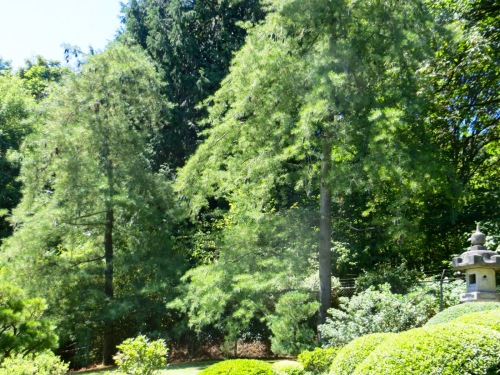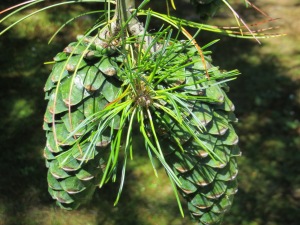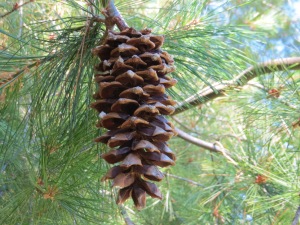| Pinus | Pine | マツ | 松 | matsu |
I was photographing some plant in the courtyard area of the Garden a few days ago when a visitor approached, asking for the name of the two ‘needle trees with a droopy, weeping growth habit and big cones by the lantern’, in north part of the Garden (Area O, by Kobe lantern). Well, I didn’t know the name, but we both looked through our Plant List booklet and decided it must be the Korean Pine. I promised to take a look and a pic when I get closer to that side of the Garden and post about the tree here – so this post is for you, gentle inquiring visitor :).
Only when I got home and took a closer look at the Plant List, I noticed that there are actually three Korean Pines in that area: two ‘armandii x P. koraiensis’ and one plain ‘koraiensis’; because the simple ‘koraiensis’ is described as growing east of the lantern, I rather safely assumed (please set me straight if wrong, people on the Plant Group) that the two I want looking at, which both grow West of the lantern, must be the ‘armndii x P’ ones.
The visitor also brought my attention to green fruit/seed pods (?) now covering Paulownia tomentosa tree in the courtyard (Area A), so look for updating that post shortly…
I couldn’t find anything exactly on p. armandii x P. koraiensis, so below entries for p. armandii and p. koraiensis – the ones we have must be some hybrid/cross between the two of them. And, from the department of ‘your question finally answered’ just found out that Korean Pine is a source of the pine nuts – always wondered what kind of pine tree those tasty pesto sauce ingredient come from….
From wikipedia: The tree species Pinus koraiensis is commonly called Korean pine. It is native to eastern Asia: Korea, Manchuria, Mongolia, the Temperate rainforests of the Russian Far East, and central Japan. In the north of its range, it grows at moderate altitudes, typically 600 metres (2,000 ft) to 900 metres (3,000 ft), whereas further south, it is a mountain tree, growing at 2,000 metres (6,600 ft) to 2,600 metres (8,500 ft) altitude in Japan. It is a large tree, reaching a mature size of 40 metres (130 ft) to 50 metres (160 ft) height, and 1.5 metres (4.9 ft) to 2 metres (6.6 ft) trunk diameter.
It is a member of the white pine group, Pinus subgenus Strobus, and like all members of that group, the leaves (‘needles’) are in fascicles (bundles) of five,[citation needed] with a deciduous sheath. They are 7 centimetres (2.8 in) to 13 centimetres (5.1 in) long. Korean pine cones are 8 centimetres (3.1 in) to 17 centimetres (6.7 in) long, green or purple before maturity, ripening brown about 18 months after pollination. The 14 millimetres (0.55 in) to 18 millimetres (0.71 in) long seeds have only a vestigial wing and are dispersed by Spotted Nutcrackers.
[…] The seeds are extensively harvested and sold as pine nuts, particularly in northeastern China; it is the most widely traded pine nut in international commerce. The nut oil contains 11.5% of the unusual fatty acid pinolenic acid. […]
From wikipedia: Pinus armandii (family Pinaceae), the Chinese white pine, is a species of pine native to China, occurring from southern Shanxi west to southern Gansu and south to Yunnan, with outlying populations in Anhui and Taiwan; it also extends a short distance into northern Burma. In Chinese it is known as “Mount Hua pine” (华山松).
It grows at 1,000-3,300 m altitude, with the lower altitudes mainly in the northern part of the range. It is a tree reaching 35 m (115 ft) height, with a trunk up to 1 m (3 ft 3 in) in diameter.
It is a member of the white pine group, Pinus subgenus Strobus, and like all members of that group, the leaves (‘needles’) are in fascicles (bundles) of five, with a deciduous sheath. They are 8–20 cm long. The cones are 9–22 cm long and 6–8 cm broad, with stout, thick scales. The seeds are large, 10–16 mm long and have only a vestigial wing; they are dispersed by spotted nutcrackers. […]
The tree, because of its evergreen foliage, is considered by the Chinese as an emblem of longevity and immortality. Its resin is considered an animated soul-substance, the counterpart of blood in men and animals. In ancient China, Taoist seekers of immortality consumed much of the tree’s resin, hoping thereby to prolong life. […]
Here is a fascinating 5 minutes video I found on the Korean Pine Trees:




